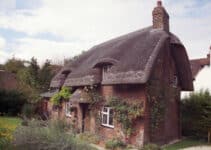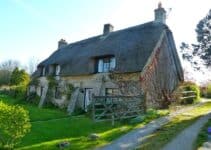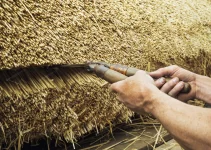There are many misconceptions about the durability and longevity of thatched roofs. When constructed from top-quality materials, by a highly-skilled thatcher, they can easily last for as long as a typical tiled roof.
Lifespan of a Thatched Roof
How long does a thatched roof last? According to Heart of England Thatchers, a thatched roof can last between 15 and 40 years if properly maintained.
Thatching is by far the oldest roofing technique. Although its use has declined nowadays, it still remains popular for those wishing to add character and individuality to a property.
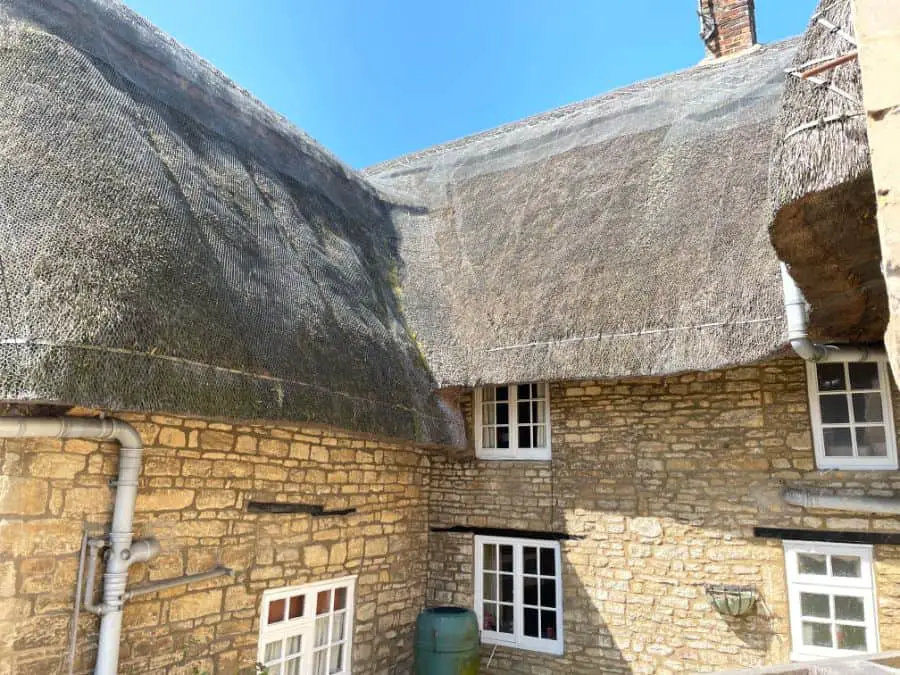
Thatched Roof Lifespan
A thatched roof lifespan can depend on many different factors, such as:
- The type and quality of the materials used
- The thatcher’s experience and skill
- The pitch of the roof
- The location of the property – geographical features, weather, pollutants, etc.
- How well the roof is maintained
- Damage from wildlife, e.g. birds or squirrels
How Often Should A Thatched Roof Be Replaced?
A thatched roof typically needs replacing every 20 to 60 years, depending on the materials used, climate, and maintenance. Water reed lasts 40-60 years, combed wheat reed 25-40 years, and long straw 20-30 years.
Regular inspections and timely repairs can prolong a thatched roof’s life expectancy. But we will discuss each in more detail, because depending on the thatching material used is one of the most important things to consider when working out how long it will last.
Water reed thatch is considered to be the longest-lasting material. Well-maintained water reed roofs can sometimes go more than 40 years before being replaced – although generally last for around 30 years.
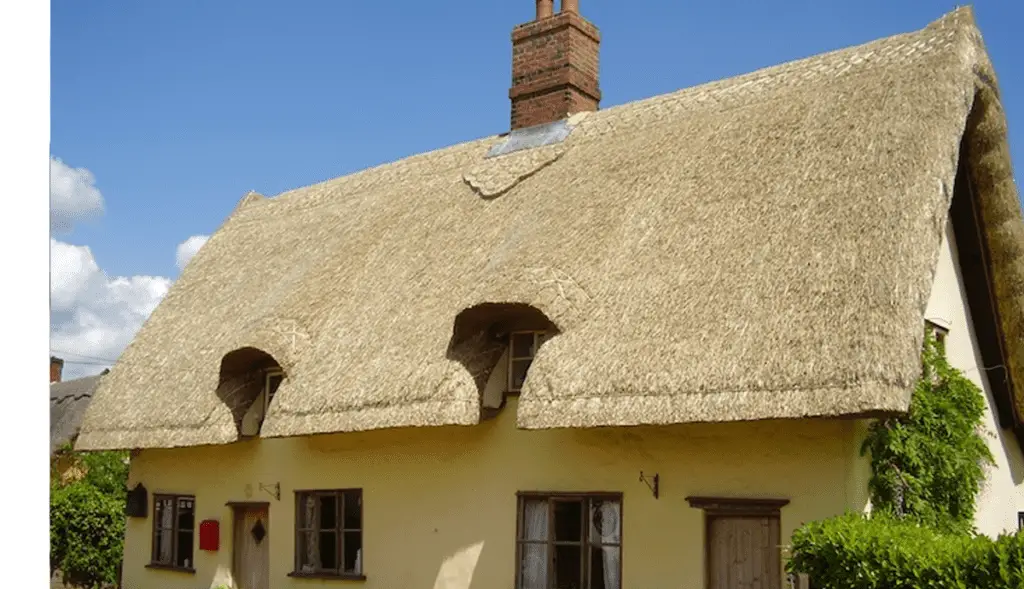
Combed wheat reed comes a close second, and can last between 25 and 35 years, while those who opt for long straw thatch can expect to replace this around every 15 years.
The ridges of a thatched roof last around 10 to 15 years, on average.
The key to getting the longest life out of a thatched roof is regular maintenance by a skilled thatcher, using the correct tools. It’s generally recommended that they visit once a year, to inspect the roof and make any necessary repairs.
Owners of thatched cottages can expect to pay around £1,000 for each annual service.
The skill of the thatcher who constructs and maintains the roof can also be vitally important, and owners should do their research when choosing a craftsman.
Inexperienced thatchers have been known to do damage to roofs, due to being unfamiliar with the materials they are working with, or the type of property.
The pitch of the roof is something that may not spring to mind when considering the longevity of thatching. A steeply pitched roof will tend to last the longest, as the angle allows for water to flow off it faster.
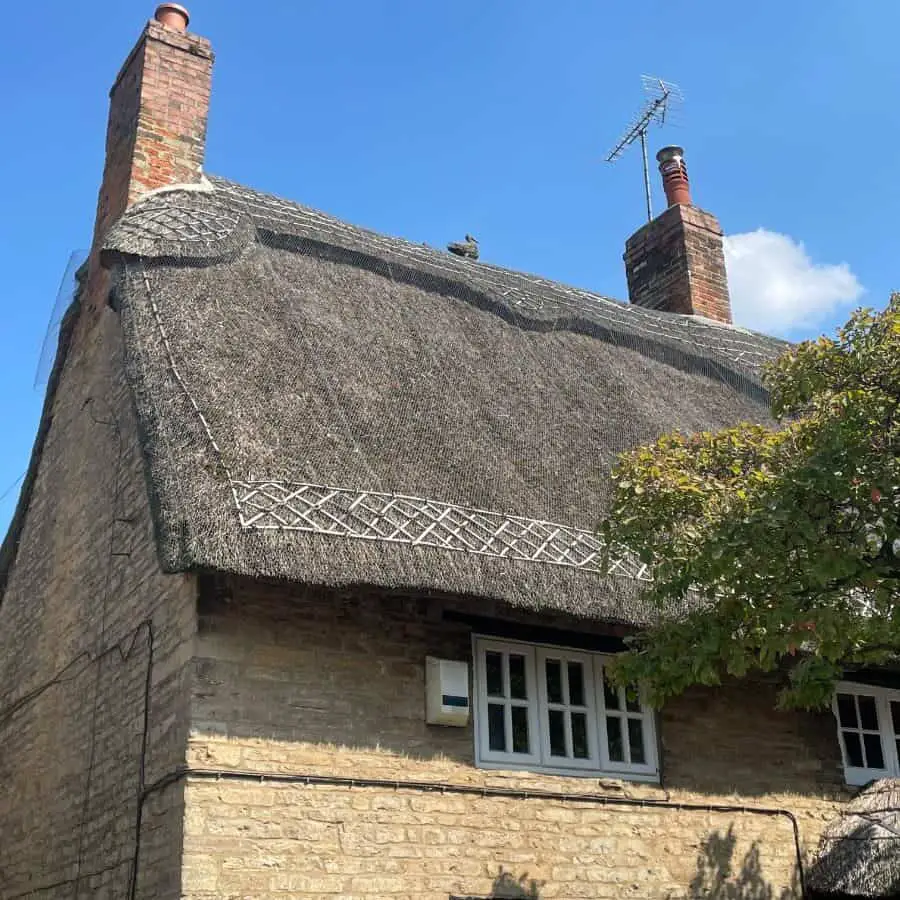
If the angle is not steep enough, rainwater could be allowed to penetrate the roof, causing it to decay faster. A gradient of 45 degrees or more will generally prolong the life expectancy of the thatch.
A property’s surroundings can play a part in the durability of the thatched roof. For example, cottages that are surrounded by a lot of trees sometimes end up with sap dripping onto the thatch.
This can cause bacteria to breed, which can in turn lead to the roof deteriorating more rapidly.
When To Replace A Thatched Roof
Maintenance and repairs will extend the life of a roof, but owners of thatched cottages should look out for these warning signs, which could indicate that it might be time to re-thatch:
- A leak in the roof that a thatcher has been unable to repair
- A roof that has been shedding thatch over a long period of time
- A visible dip or sag in the thatched roof
- A roof that has simply come to the end of its lifespan
According to checkatrade.com, the average cost to replace a thatched roof is in the region of £22,500, but prices will vary.
How Long Does A Thatched Roof Last in England?
Although England has its fair share of rugged coastal areas, thatched cottages are generally to be found in sheltered inland towns and villages.
England’s longest-lasting thatched roofs are situated in the East Anglia area, where it’s not uncommon to find a water reed roof that is 60 years old. This has been attributed to the region’s low rainfall.
In contrast, property owners on the drizzly west coast of England might find that their thatched roof only lasts around half of that time.
Those living in thatched cottages that are close to a larger town or city may discover that their roof deteriorates faster than their country counterparts. This is due to pollutants from chemicals like petrol and diesel.
How Long Does a Thatched Roof Last in Ireland?
Ireland, with its more rural surroundings and its abundance of exposed coastline, offers different points for consideration.
The relative scarcity of metropolitan areas means that the detrimental effects of pollution are less of a concern. However, the wet and windy Irish climate means that the lifespan of the average thatched roof is estimated to be around 30 years.
How Durable are Thatched Roofs?
A thatched roof is remarkably durable when properly constructed and maintained. With a lifespan of up to 50 years, water reeds are considered the most durable material, while long straw and combed wheat reed last around 25-30 years.
To enhance durability, proper installation techniques should be employed, such as ensuring a steep pitch and secure fixings. Maintenance plays a crucial role in the roof’s longevity, with minor repairs being conducted every few years.
Thatched roofs are resistant to wind and rain, due to their dense construction, and offer excellent insulation. However, they are susceptible to damage from rodents, birds, and insects if not properly protected.
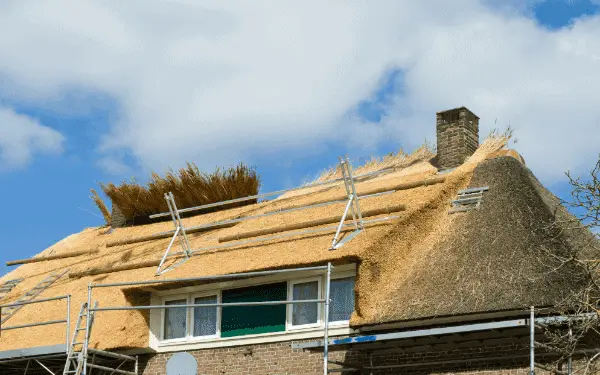
Problems With Thatched Roofs
Here are some of the potential issues associated with thatched roofs, along with some of the ways they can be prevented.
Because a thatched roof is made to be waterproof, it can prove very difficult to extinguish a fire once it starts. Fire can also spread more quickly on thatch than on other materials.
For this reason, there are some fire prevention steps that should be considered by every thatched cottage owner.
1. Apply a fire retardant spray to the thatch.
2. Take extra care if lighting a wood-burning fire – research has shown that ejected embers from chimney fires are one of the greatest dangers to thatched roofs. It’s recommended to fit a chimney heat monitor with an alarm.
3. The roof void of a thatched property is extremely dry, making it more flammable. Smoking should be avoided, and candles should never be lit in this area.
It is a misconception that thatched roofs are more likely to catch fire than conventional roofs. However, the scale of the damage that can be done in the case of a thatch fire makes it harder and more expensive to insure thatched properties.
Rodents, Birds And Insects
Spiders and other insects love the habitat of a thatched roof. These creepy crawlies can attract birds, who pull out the thatch in search of their next meal. Birds also sometimes take straw for their nests.
Squirrels can be particularly problematic, as they can quickly make a mess of thatch by chewing through both the straw and even electrical cables (creating a fire risk).
Pests can be removed from thatched roofs by specialists, who will use techniques such as traps and poison. To prevent future problems, it is important to find out how they first got into the thatch, then rectify that issue.
The Pitch Of The Roof
As previously mentioned, if a thatched roof slopes too gently, moisture will not slide off it efficiently and it can even become overloaded with snow. A roof with a pitch that is too low can be built up with additional thatch in order to create an acceptable angle.
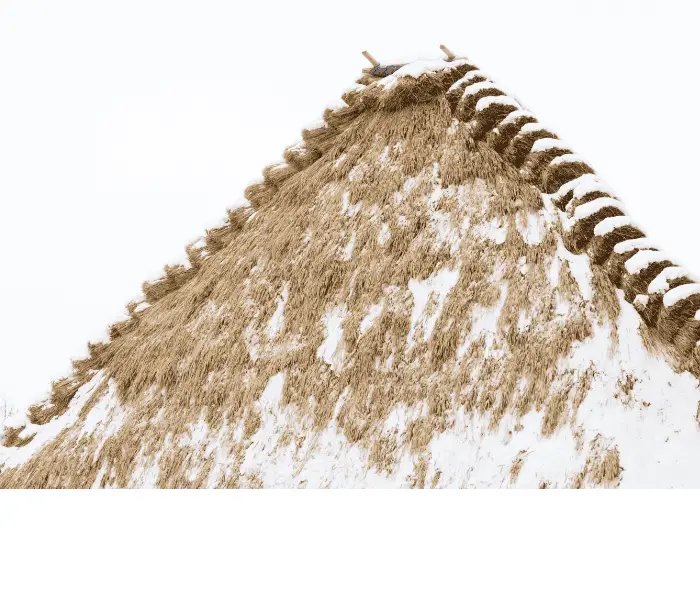
Advantages Of Thatched Roofs
Although they can have their drawbacks, thatched roofs do actually have a few advantages over conventional roofs, such as:
- They look beautiful, add character and are unique. A thatched roof can add value to a property.
- They are naturally breathable, which combats rotting.
- A thatched roof will insulate the property in the winter and also keep it cool in the summer because of the natural air pockets in the straw. This can help save money on energy bills.
- Thatched roofs are environmentally friendly because they’re constructed from natural materials.
- There is no need to install gutters or drainpipes, so a thatched roof is cost-effective in this way.
How Long Do Thatched Roofs Last?
In conclusion, thatched roofs have been a timeless and charming architectural feature for centuries, offering both aesthetic and practical advantages. With proper maintenance, a thatched roof can last anywhere between 20 to 70 years, depending on the materials used and the climate.
Water reed and combed wheat reed tend to have a longer lifespan, while long straw is more vulnerable to wear and tear.
Thatched roofs require regular inspections and maintenance to ensure their longevity. It is recommended to have your roof inspected by a professional thatcher every 2-5 years, and repairs should be done promptly to prevent further damage.
The expertise of a skilled thatcher is essential in prolonging the life of a thatched roof, making it a worthwhile investment.
While thatched roofs may have higher upfront costs, the long-term benefits include better insulation, eco-friendliness, and a visually appealing appearance that adds character to any home.
By choosing the right materials and employing the services of an experienced thatcher, homeowners can enjoy the unique charm and durability of a thatched roof for decades to come.
